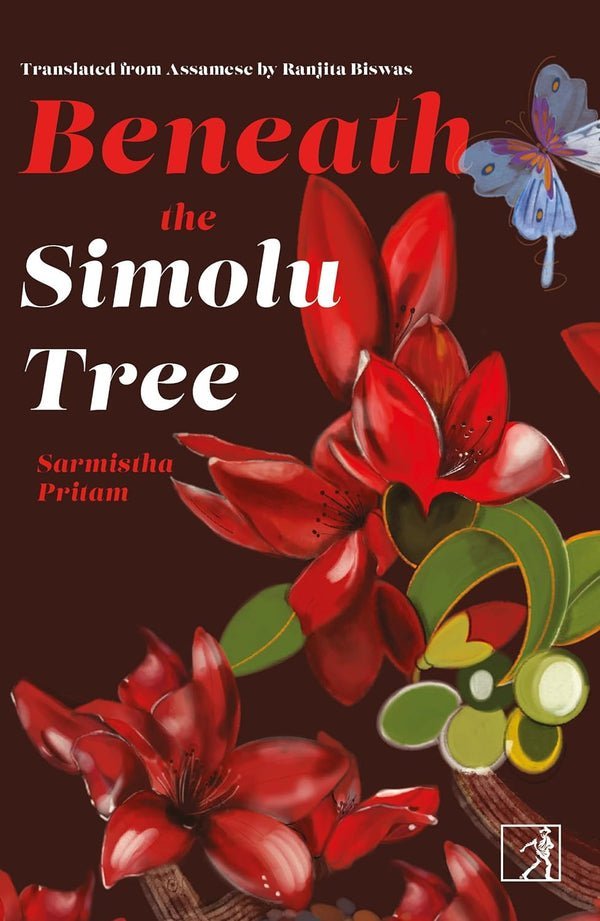Beneath the Simolu Tree is a contemporary novel, originally written in Assamese by Sarmistha Pritam and translated into English by Ranjita Biswas. Published in 2024 by Simon and Schuster, the text tells the tale of Paridhi, a young woman who has grown up in a village in Assam. Quiet, imaginative and sensitive as a little girl, Paridhi faces and witnesses violence, discrimination and trauma early on in life. The young woman she grows up into is passionate, fiercely loving and resolute. The novel traces Paridhi’s journey of blossoming into a promising young writer, a creative artist and a kind, caring woman.
Gender, violence and breaking free
As a girl, Paridhi lives in a house with her violent, alcoholic father, her frightened and timid mother, her elder brother who nurtures the dream of acting and her bordeuta’s (father’s older brother) family. Her uncle is everything her father could never be- a school teacher by profession, he is kind hearted, loving and encourages Paridhi to pursue her dreams. He and his wife have two sons- the younger son becomes a revolutionary and runs away from home while the older son, Dipak, Paridhi’s Shontu-da, lives in the city with his wife and his little boy.
In Beneath the Simolu Tree, Paridhi’s father beats up her and her mother and abuses them in his bouts of drunken rage. He tries to kill Paridhi’s dream of becoming an artist- instead it is her bordeuta who nurtures the creative in her. Growing up, watching and facing alcohol induced violence at close quarters, Paridhi and her brother Paras are determined to shut down the village drinking hole- the bhaati khana forever. Alcohol abuse and drink-induced violence is a recurrent occurrence in Beneath the Simolu Tree– Paridhi’s neighbour Joydev is a drunkard who steals from his hardworking mother to fund his addiction.
Alcohol abuse and drink-induced violence is a recurrent occurrence in Beneath the Simolu Tree– Paridhi’s neighbour Joydev is a drunkard who steals from his hardworking mother to fund his addiction.
The ones who have to pay for this addiction are the women who are battered, betrayed, left to fend for themselves and the family, and at times, even killed. Growing up in a culture of violence, Paridhi carries forward a lot of trauma into adulthood. She is, justifiably, never able to forgive her father or forget what he did to the family. But as an older Paridhi takes care of her ailing uncle, greying mother and manages the household with her writing and art, she is staunch in her resolve to break free from this toxic system of abuse. Her resolve and determination stays strong throughout.
Caste and class in Beneath the Simolu Tree
Daily instances of overt and covert casteism are part and parcel of Paridhi’s life in a conservative, close-minded village, as depicted in Beneath the Simolu Tree. She cannot help but notice how some people in the village are treated poorly because of their caste identity, even in her own home. They are given tea in a glass instead of a cup and saucer and the stools they sit on are washed after they leave, in order to purify them from the touch of an “untouchable”. In Paridhi’s village, families where there are inter caste marriages, are excommunicated until the inter caste couple leaves the village home forever. When the couple who have committed the grave “sin” of marrying outside their caste is driven away from the family home, the house undergoes a purifying ritual to cleanse it of the sin.
In fact, Paridhi, who falls in love and enters into a relationship with Bondeep, a boy from an upper caste Brahmin family, is no stranger to facing abject casteism and discrimination from Bondeep’s mother, a proud Brahmin woman. Fearing excommunication, Bondeep’s mother confronts Paridhi, forcing her to leave her son. Even Paridhi’s own family is doubtful and discouraging about her relationship with Bondeep. Caste lines are made even more prominent as Paridhi, ultimately, is forced to let go of her love and move on.
Poverty is yet another integral theme in Beneath the Simolu Tree. From Joydev’s labourious mother who brings up her son on her own to Tilottoma, a local woman who can barely make ends meet, Paridhi sees the people around her battling poverty on a daily basis. Bondeep, too, had grown up with a single mother providing for him and his brothers. In his situation of extreme poverty, he, too, has to help out from an early age. Paridhi’s best friend Juroni, a vivacious and tenacious young woman becomes the sole earner for her large family. She spends her hard earned money lavishly on herself and manages her family. However, when she is found to have deadly breast cancer, she is unable to afford good doctors and willingly refuses expensive treatments.
In Paridhi’s own home, her bordeuta is the sole earning member for a long time and though they are able to make it by, Paridhi is often denied the right to dream by her father, who says she cannot afford to nurse a hobby like art.
Nature and the power of the creative mind in Beneath the Simolu Tree
To escape her trauma and struggles, Parodhi finds solace in the natural world and her creative imagination. She feels at peace beneath the simolu tree in the village, which is presumed to be haunted and avoided by many. She watches trains pass by and contemplates on the platform about life. Her imagination and creativity manifest themselves in her paintings, on paper and on pebbles, and in her stories. She has a penchant for painting on rocks and pebbles. In fact, it is through her art that she connects with a creative naturalist, her friend, Mayur, who is passionate about butterflies and the local ecology.
The motif of nature finds its way into almost every page in Beneath the Simolu Tree, portraying Paridhi’s girlhood in the lap of nature.
The motif of nature finds its way into almost every page in Beneath the Simolu Tree, portraying Paridhi’s girlhood in the lap of nature. The natural world inspires creativity and art, exemplifying the symbiosis and syncretism between nature and creative imagination.
Through her art, Paridhi connects with the young station master whom she fondly calls Station-khura. The latter teaches her all about great art and artists and kindles the creative fire in her. Her love for literature and stories lead her to Anuja-khuri who shares books with her and later, to Bondeep, her beau. In Beneath the Simolu Tree, Paridhi, in spite of her reticent nature, is able to spiritually connect with like minded people through shared creative interests and her sensitive and empathetic nature.
A rural coming-of-age
In a world where the recent discussions and narratives around girlhood and coming of age are limited to elite, urban spaces, Paridhi’s simple, yet nuanced narrative of becoming a woman is ensconced in the lap of rural simplicity, replete with the pains and passions that adorn the lives of village girls in India. Paridhi is like any other girl who has grown up in the lap of nature, in a conservative rural society. However, what makes her memorable is her drive, determination and unbreakable spirit. A loving and sensitive young woman who is also creative and talented, Paridhi seems relatable and commonplace, but is actually a very unique and special girl.
In a time when discourses and narratives of and around girlhood are gaining prominence in the cultural milieu, it is essential to include and highlight narratives like Paridhi’s story in Beneath the Simolu Tree which is a raw, real and relatable account of what it means to be a girl blossoming into womanhood in rural India.
About the author(s)
Ananya Ray has completed her Masters in English from Jadavpur University, Kolkata, India. A published poet, intersectional activist and academic author, she has a keen interest in gender, politics and Postcolonialism.









It’s pivotal to excavate the rural narrative and to constellate the everyday lived experiences of social bodies who make their symbolic space through the fluidity of polyrhythmic performativity in a unique way. Although the book is based on Assam that talks about everyday performativity through the social, cultural and geographical signifier from a feminist standpoint. I would like to see how women who identify themselves as queer or non-normative carve their imprint in the diversified rural spaces of India. With so many villages embodying the myriad mosaic of intersectional and socio-cultural complexity, it will be an important territory to explore.